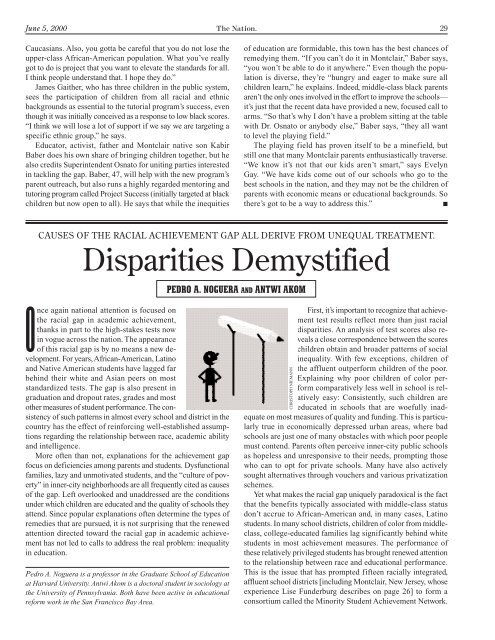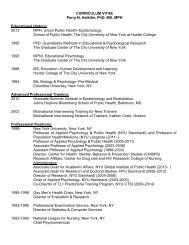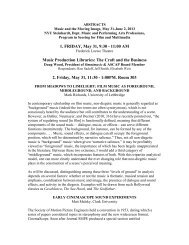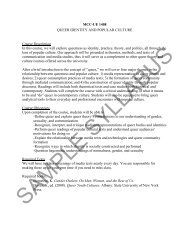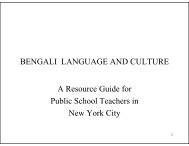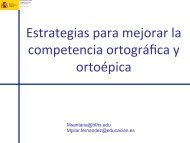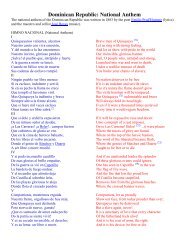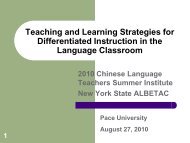Disparities Demystified - NYU Steinhardt
Disparities Demystified - NYU Steinhardt
Disparities Demystified - NYU Steinhardt
Create successful ePaper yourself
Turn your PDF publications into a flip-book with our unique Google optimized e-Paper software.
June 5, 2000 The Nation. 29<br />
Caucasians. Also, you gotta be careful that you do not lose the<br />
upper-class African-American population. What you’ve really<br />
got to do is project that you want to elevate the standards for all.<br />
I think people understand that. I hope they do.”<br />
James Gaither, who has three children in the public system,<br />
sees the participation of children from all racial and ethnic<br />
backgrounds as essential to the tutorial program’s success, even<br />
though it was initially conceived as a response to low black scores.<br />
“I think we will lose a lot of support if we say we are targeting a<br />
specific ethnic group,” he says.<br />
Educator, activist, father and Montclair native son Kabir<br />
Baber does his own share of bringing children together, but he<br />
also credits Superintendent Osnato for uniting parties interested<br />
in tackling the gap. Baber, 47, will help with the new program’s<br />
parent outreach, but also runs a highly regarded mentoring and<br />
tutoring program called Project Success (initially targeted at black<br />
children but now open to all). He says that while the inequities<br />
CAUSES OF THE RACIAL ACHIEVEMENT GAP ALL DERIVE FROM UNEQUAL TREATMENT.<br />
<strong>Disparities</strong> <strong>Demystified</strong><br />
Once again national attention is focused on<br />
the racial gap in academic achievement,<br />
thanks in part to the high-stakes tests now<br />
in vogue across the nation. The appearance<br />
of this racial gap is by no means a new development.<br />
For years, African-American, Latino<br />
and Native American students have lagged far<br />
behind their white and Asian peers on most<br />
standardized tests. The gap is also present in<br />
graduation and dropout rates, grades and most<br />
other measures of student performance. The consistency<br />
of such patterns in almost every school and district in the<br />
country has the effect of reinforcing well-established assumptions<br />
regarding the relationship between race, academic ability<br />
and intelligence.<br />
More often than not, explanations for the achievement gap<br />
focus on deficiencies among parents and students. Dysfunctional<br />
families, lazy and unmotivated students, and the “culture of poverty”<br />
in inner-city neighborhoods are all frequently cited as causes<br />
of the gap. Left overlooked and unaddressed are the conditions<br />
under which children are educated and the quality of schools they<br />
attend. Since popular explanations often determine the types of<br />
remedies that are pursued, it is not surprising that the renewed<br />
attention directed toward the racial gap in academic achievement<br />
has not led to calls to address the real problem: inequality<br />
in education.<br />
Pedro A. Noguera is a professor in the Graduate School of Education<br />
at Harvard University. Antwi Akom is a doctoral student in sociology at<br />
the University of Pennsylvania. Both have been active in educational<br />
reform work in the San Francisco Bay Area.<br />
PEDRO A. NOGUERA AND ANTWI AKOM<br />
of education are formidable, this town has the best chances of<br />
remedying them. “If you can’t do it in Montclair,” Baber says,<br />
“you won’t be able to do it anywhere.” Even though the population<br />
is diverse, they’re “hungry and eager to make sure all<br />
children learn,” he explains. Indeed, middle-class black parents<br />
aren’t the only ones involved in the effort to improve the schools—<br />
it’s just that the recent data have provided a new, focused call to<br />
arms. “So that’s why I don’t have a problem sitting at the table<br />
with Dr. Osnato or anybody else,” Baber says, “they all want<br />
to level the playing field.”<br />
The playing field has proven itself to be a minefield, but<br />
still one that many Montclair parents enthusiastically traverse.<br />
“We know it’s not that our kids aren’t smart,” says Evelyn<br />
Gay. “We have kids come out of our schools who go to the<br />
best schools in the nation, and they may not be the children of<br />
parents with economic means or educational backgrounds. So<br />
there’s got to be a way to address this.” ■<br />
First, it’s important to recognize that achievement<br />
test results reflect more than just racial<br />
disparities. An analysis of test scores also reveals<br />
a close correspondence between the scores<br />
children obtain and broader patterns of social<br />
inequality. With few exceptions, children of<br />
the affluent outperform children of the poor.<br />
Explaining why poor children of color perform<br />
comparatively less well in school is relatively<br />
easy: Consistently, such children are<br />
educated in schools that are woefully inadequate<br />
on most measures of quality and funding. This is particularly<br />
true in economically depressed urban areas, where bad<br />
schools are just one of many obstacles with which poor people<br />
must contend. Parents often perceive inner-city public schools<br />
as hopeless and unresponsive to their needs, prompting those<br />
who can to opt for private schools. Many have also actively<br />
sought alternatives through vouchers and various privatization<br />
schemes.<br />
Yet what makes the racial gap uniquely paradoxical is the fact<br />
that the benefits typically associated with middle-class status<br />
don’t accrue to African-American and, in many cases, Latino<br />
students. In many school districts, children of color from middleclass,<br />
college-educated families lag significantly behind white<br />
students in most achievement measures. The performance of<br />
these relatively privileged students has brought renewed attention<br />
to the relationship between race and educational performance.<br />
This is the issue that has prompted fifteen racially integrated,<br />
affluent school districts [including Montclair, New Jersey, whose<br />
experience Lise Funderburg describes on page 26] to form a<br />
consortium called the Minority Student Achievement Network.<br />
CHRISTOPH NIEMANN
30 The Nation. June 5, 2000<br />
TheNation.<br />
Teachers and Professors!<br />
Bringing national and global events to life in<br />
the classroom isn’t easy. Textbooks are out of<br />
date. Mainstream periodicals supply only the<br />
conventional wisdom.<br />
So how can you interest your students in current<br />
events and get them debating the topics of<br />
the day?<br />
Use The Nation in your classroom.<br />
Your students will<br />
read provocative,<br />
award-winning<br />
articles covering<br />
the latest in politics<br />
and the arts,<br />
and they’ll be<br />
exposed to the<br />
kind of alternative<br />
news and opinion<br />
that will get them<br />
talking.<br />
For more<br />
information, write:<br />
Classroom Program, The<br />
Nation,<br />
33 Irving Place,<br />
New York, NY 10003<br />
or call<br />
Peggy Randall at<br />
(212) 209-5428<br />
prandall@thenation.com<br />
Our Classroom<br />
Education<br />
Program offers<br />
semester-length<br />
bulk subscriptions<br />
at special student<br />
rates to help you<br />
use The Nation<br />
with your class.<br />
Making a Will?<br />
It’s important for you. And important for us that you consider<br />
making The Nation part of your legacy. By making a<br />
provision for The Nation now, you help ensure that both<br />
the principles we stand for, and the forum in which we<br />
fight for them, will be around for generations to come. Your<br />
legacy can take the form of a will, a trust, or various other<br />
means. It can go to The Nation or to The Nation Institute,<br />
a tax exempt charitable organization. And of course it can<br />
be – and will be appreciated – in whatever amount you can<br />
make it, large or small. It’s spelled out in what we call our<br />
Legacy Group brochure. If you’re at an estate-planning<br />
point in your life, or feel you’d like to know more about<br />
your options in general, call us for a copy.<br />
The Nation Legacy Group<br />
(212) 209-5428<br />
The Nation. 33 IRVING PLACE, NEW YORK, NY 10003-2332<br />
With the support of researchers assembled by the College Board,<br />
the network, comprising districts in such communities as White<br />
Plains, New York, Ann Arbor, Michigan, and Berkeley, California,<br />
seeks to understand the causes of the racial achievement gap<br />
and to devise solutions for reversing it.<br />
On the face of it, the potential for success in reducing the gap<br />
in these districts would seem high. All fifteen school districts<br />
in the network have a track record of sending large numbers of<br />
affluent white students to the best colleges and universities in<br />
the country. Additionally, unlike schools in high-poverty areas,<br />
funding is largely not a major obstacle to reform. Each district<br />
is located in an affluent community with a highly educated<br />
population known for its commitment to liberal political and social<br />
values. Yet in all fifteen districts there is a persistent, deeply<br />
ingrained sense that even this ambitious and well-intentioned<br />
effort will fail to alter student outcomes.<br />
The pessimism in these districts, and in others that have<br />
launched efforts to overcome the racial achievement gap, must be<br />
understood in historical context. In many areas greater emphasis<br />
has been placed on how to achieve racial integration in schools<br />
than on how to serve the educational needs of a diverse student<br />
population. Even in the liberal districts in the Minority Student<br />
Achievement Network, some of which were among the first in<br />
the nation to voluntarily desegregate, the arrival of significant<br />
numbers of students of color in the late sixties and early seventies<br />
met with considerable opposition. From the very beginning, the<br />
presence of African-American children, especially those from<br />
low-income families, was perceived as an intrusion, and because<br />
the children were perceived as disadvantaged and deficient in<br />
comparison with their white schoolmates, educating them has<br />
always been regarded as a challenge. Since students of color<br />
were framed as “problems” and “challenges” from the very start,<br />
it is hardly surprising that they would continue to be treated as<br />
a problem requiring special intervention years later.<br />
Moreover, educational practices often have the effect of favoring<br />
white students and hindering the educational opportunities<br />
of African-Americans and Latinos. This is particularly true when<br />
it comes to tracking and sorting students on the basis of ability.<br />
A large body of research has shown that students of color are<br />
more likely to be excluded from classes for those deemed gifted<br />
in primary school, and from honors and Advanced Placement<br />
(AP) courses in high school. The Education Trust has shown,<br />
through its research on science and math education, that even<br />
students of color who meet the criteria for access to advanced<br />
courses are more likely to be turned away based on the recommendation<br />
of a counselor or teacher. They are also more likely to<br />
be placed in remedial and special-education classes, and to be<br />
subject to varying forms of school discipline.<br />
A close examination of access to AP courses in California reveals<br />
how certain educational practices contribute to the maintenance<br />
of the racial achievement gap. Since the mid-eighties,<br />
the number of AP courses available to students at high schools<br />
in California has tripled. This increase has been attributed to a<br />
1984 decision by the University of California to give greater<br />
weight to the grades earned by students who enroll in AP<br />
courses. However, AP courses are not uniformly available to<br />
students. At some inner-city and rural schools, few if any such<br />
courses are offered, while at private and affluent suburban schools,
June 5, 2000 The Nation. 31<br />
it is not uncommon for students to have access to fifteen or more<br />
AP courses [see Alan Jenkins, “Leveling the Playing Field,”<br />
March 6]. Moreover, our own research at Berkeley High School<br />
has shown that even when minority students are enrolled at<br />
schools that do offer a large number of AP courses, they are more<br />
likely to be actively discouraged from taking them by teachers<br />
and counselors.<br />
Beyond the policies and practices that contribute to the<br />
achievement gap, a number of complex cultural factors are also<br />
important. Missing from the research and policy debates is an<br />
understanding of the ways in which children come to perceive<br />
the relationship between their racial identity and what they<br />
believe they can do academ-<br />
ically. For many children,<br />
schools play an important<br />
role in shaping their racial<br />
identities because they are<br />
one of the few social settings<br />
where kids interact with people from different backgrounds. To<br />
the extent that a school’s sorting processes disproportionately<br />
relegate black and brown children to spaces within schools that<br />
are perceived as negative and marginal, it is likely that children<br />
of color will come to perceive certain activities and courses as<br />
either suitable or off-limits for them.<br />
In schools where few minority students are enrolled in AP<br />
courses, even students who meet the criteria for enrollment may<br />
refuse to take such courses out of concern that they will become<br />
isolated from their peers. The same is true for the school band,<br />
newspaper, debating team or honor society. When these activities<br />
are seen as the domain of white students, nonwhite students are<br />
less likely to join. Peer groups play a large role in determining<br />
the academic orientation of students, not to mention their style<br />
of clothes, manner of speech and future career aspirations. For<br />
middle-class African-American and Latino students, this means<br />
that despite receiving encouragement from their parents to do well<br />
in school, the peer group with whom they identify may push<br />
them in a different direction.<br />
There are also cultural factors related to the attitudes and<br />
behaviors of students and the childrearing practices of parents<br />
that influence student performance. Several studies, for example,<br />
have indicated that middle-class African-American and Latino<br />
students spend less time on homework and study in less effective<br />
ways than middle-class white and Asian students. Also,<br />
despite the visibility of African-American students in sports<br />
such as football and basketball, research shows that these students<br />
are less likely to be involved in other extracurricular activities<br />
(which are shown to positively influence achievement),<br />
and in their responses to surveys they are more likely to emphasize<br />
the importance of being popular among friends than<br />
doing well in school.<br />
Finally, images rooted in racial stereotypes that permeate<br />
American society limit the aspirations of African-American and<br />
Latino students. Despite the daunting odds of success in professional<br />
sports and entertainment, many young people of color<br />
believe they have a greater chance of becoming a highly paid<br />
athlete or hip-hop artist than an engineer, doctor or software programmer.<br />
And with the rollback of affirmative action at colleges<br />
and universities, there is little doubt that students who possess<br />
Given the history of racism in the United<br />
States, it would actually be more surprising<br />
if a racial achievement gap did not exist.<br />
entertainment value to universities, who can slam-dunk or score<br />
touchdowns, will be admitted regardless of their academic performance,<br />
even as aspiring doctors and lawyers are turned away.<br />
When placed within the broader context of race relations in<br />
American society, the causes of the racial achievement gap appear<br />
less complex and mysterious; the gap is merely another<br />
reflection of the disparities in experience and life chances for<br />
individuals from different racial groups. In fact, given the history<br />
of racism in the United States and the ongoing reality of racial<br />
discrimination, it would be more surprising if an achievement<br />
gap did not exist. If the children of those who are most likely to<br />
be incarcerated, denied housing and employment, passed over<br />
for promotions or harassed by<br />
the police did just as well in<br />
school as those whose lives<br />
are largely free of such encumbrances,<br />
that would truly<br />
be remarkable news.<br />
Lest recognition of the racial achievement gap drive us into<br />
greater despair about the prospects for eliminating racial inequality<br />
in America, we must also recognize that to the extent<br />
change is possible, it is more likely to occur in education than<br />
in any other sector. This is because despite its faults, public education<br />
remains the most democratic and accessible institution in<br />
the country. In fact, in the post–welfare reform period, it is virtually<br />
all that remains of the social safety net for poor children.<br />
Moreover, there are schools where no achievement gap exists,<br />
and there are students who achieve at high levels despite the incredible<br />
odds facing them. These bright spots of success reveal<br />
what might be possible if we lived in a society that truly valued<br />
children and was genuinely committed to equity and high-quality<br />
education for all.<br />
Realizing such an ideal would require a comprehensive effort<br />
to reverse the effects of racial and economic inequality in the<br />
classroom, but it might begin with a few basic, though costly,<br />
measures: (1) significantly raising salaries so that teaching would<br />
be an attractive career for the best college graduates; (2) insuring<br />
that poor children have access to well-qualified teachers<br />
from diverse racial and ethnic backgrounds, and to schools with<br />
adequate resources; and (3) providing parents in low-income<br />
areas with the means to exert greater influence over the schools<br />
their children attend. These are not radical measures. Indeed,<br />
they are already features of schools in most middle-class suburban<br />
communities. But bringing them to low-income areas<br />
would require states to address the huge disparities in funding<br />
that arise from the way schools are financed throughout the<br />
country. Since the electoral defeat of former New Jersey Governor<br />
Jim Florio in 1993—the last major elected official to make a<br />
serious attempt to address such inequities—few have been willing<br />
to take on this critical issue.<br />
Despite the defeats such measures have suffered in the courts<br />
and at the polls, politicians do recognize that the public is deeply<br />
concerned about improving the quality of education, and as they<br />
clamor to position themselves as friends and supporters of education<br />
we must demand that they address questions of equity. For<br />
those of us who believe that public education can serve as a<br />
source of hope and opportunity, the time is ripe for making our<br />
voices heard so this historic opportunity is not missed. ■


